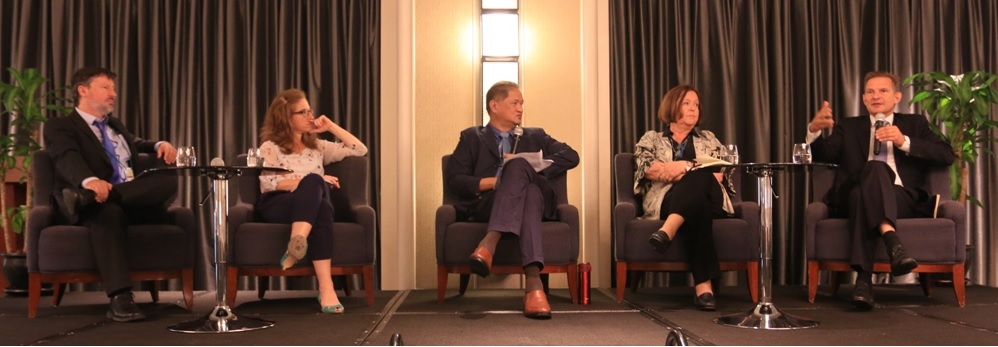PEMSEA Taps Experts on Financing for Ocean Investment
Thursday, 3 August 2017

New instruments and approaches for financing the conservation and protection of ecosystems are emerging seemingly every day. In East Asia, PEMSEA’s 11 Country Partners are seeking to move beyond traditional public financing to fully utilize a blend of both public and private finance to support sustainable development of coasts and oceans in the region. As part of its annual East Asian Seas Partnership Council Meeting, PEMSEA convened a panel of international experts for an Ocean Leadership Roundtable held July 26. Representatives from national governments, NGOs, development projects, research institutes and industry associations from around the region learned about green bonds, blue carbon, waste water as a resource and the development of a new ocean investment facility, and how these might be applied in East Asia.

Green Bonds
Justine Leigh-Bell of the Climate Bonds Initiative (CBI) explained to the participants that green bonds are debt instruments issued to finance green projects and assets. While no different than traditional bonds, the “green” label signals that the proceeds of the bonds go to environmentally responsible investments, such as renewable energy, low carbon buildings and waste management. The demand for green bonds is growing at a tremendous rate, so much so that some newly issued bonds are oversubscribed within a few hours. This market represents potentially trillions of dollars that could be tapped, and demand continues to grow as investors increasingly elect for financial instruments that can offer environmental benefits.
In partnership with PEMSEA, CBI is exploring the potential of applying bond financing to investments supporting coastal sustainable development, leveraging the same mechanics as green bonds and targeting the same buyers. Potential issuers could include central governments along with national and regional development banks. CBI identified Indonesia, the Philippines, Vietnam and China as having high potential based on several factors, including the advancement for integrated coastal management (ICM) implementation, the stability of domestic capital markets and a strong interest in green finance.
Blue Carbon
Dr. Stephen Crooks of Silvestrum Climate Associates discussed the urgency of investing in blue carbon ecosystems, particularly in East Asia, which is a global hotspot for these ecosystems. Blue carbon ecosystems refer to mangroves, seagrass meadows and tidal marshes. All play a key role in carbon sequestration, which mitigates the impacts of climate change.
In June 2017, PEMSEA published a report in partnership with Silvestrum Climate Associates, Conservation International and The Nature Conservancy on Strategic Coastal Blue Carbon Opportunities in the Seas of East Asia. The report seeks to better understand the status of coastal blue carbon ecosystems in East Asia and raise awareness of the opportunities to include improved management of these ecosystems within climate mitigation and adaptation actions and commitments, including opportunities to access new forms of financing.
Globally, blue carbon ecosystems are disappearing at an alarming rate, approximately 1% per year. Steps are being taken to address this decline, including establishment of an EUR 80 million Blue Natural Capital Facility and Fund, led by Luxembourg and the International Union for Conservation of Nature (IUCN), focused on developing investible blue carbon projects. The Paris Climate Agreement has helped to mobilize action and there are a number of steps that countries can take to advance the management of blue carbon ecosystems for climate response planning and blue economy growth.
Regional Ocean Investment Facility & Funds
Coasts and oceans have significant potential as a new investment asset class. Dr. Veerle Vandeweerd, former Director at UN Environment and UNDP, pointed out the opportunity in building on the scientific, policy and action frameworks established by the Global Environment Facility, which can provide fertile ground for sustainable investments. The time is right to shift from action planning to investment, and East Asia is ripe for investment in coasts and oceans. There continues to be a need for new financial instruments and the application of traditional finance, but more importantly the development of pipelines of investible projects and the policies needed to provide an enabling environment for investment.
PEMSEA and Dr. Vandeweerd are developing an Ocean Investment Facility & Funds in partnership with regional and international partners. An example of one fund focused on waste water as a resource was presented by Dr. Ger Bergkamp of ARCOWA. Dr. Bergkamp shared several examples of waste water projects that generate income for investors through production of energy (biogas), fertilizer, minerals and water re-use. Such a fund would be managed by professional fund managers, while PEMSEA supports development of a pipeline of investible projects in the region.
Opportunities, Challenges and the Way Forward
In a review of ICM sites across East Asia, potential investment projects were identified across a wide range of sectors, including water supply, pollution reduction and waste management, fisheries and aquaculture, ecotourism, ports and climate smart infrastructure. These initiatives are aligned with the UN Sustainable Development Goals, which provide a useful entry point for sustainable investments.
Engaging in innovative financing for sustainable development of coasts and oceans is relatively new and not without its challenges, especially in the complex ocean context. Chief among the challenges is a lack of capacity in the region to develop pipelines of investible projects, which the Ocean Investment Facility can address. Despite the challenges, participants at the Ocean Leadership Roundtable expressed great interest in learning more about these approaches, recognizing the risks of embarking on any new venture.
PEMSEA and its partners are blazing a path as one of a few organizations globally that has initiated a move towards new investment mechanisms supporting blue economy development across a range of coastal and ocean sectors. We look forward to sharing the learnings from this new endeavor and to establishing a new mechanism that can support sustainable development coasts and oceans, in East Asia and other parts of the world.



